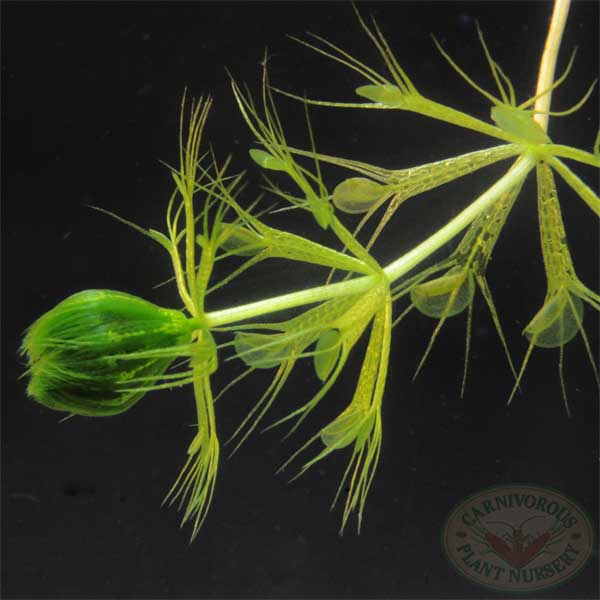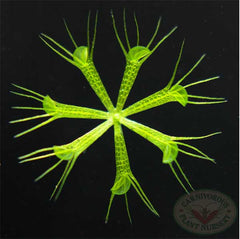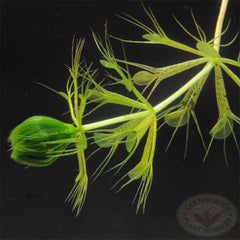
Growing Tips for Aldrovanda



Water Wheel Plant - Aldrovanda vesiculosa
Soil: peaty water (color of Guiness) with decaying leaf litter
Container: shallow water-filled tub or aquarium, larger the better
Watering: aquatic, submerged growing CP
Light: part sun to dappled shade
Temperature: warm summer, cool winter, tolerates frost
Humidity: 100%, submerged aquatic
Location: garden bog pool, windowsill, aquarium, greenhouse
Dormancy: yes, forms turion for temperate varieties. Red tropical form does not require dormancy
Habitat
The Waterwheel Plant, Aldrovanda vesiculosa, is native to the bog pools of Africa, Asia, Australia, and Europe. It grows submerged in acidic, peaty water that is low in nutrients, but rich in decaying leaf litter. The typical climate is warm temperate. The mean summer water temperature is 80°F (27°C) and the mean winter water temperature is 40°F (4°C) with water temperature ranges between 35-90°F (2-32°C). Air temperatures can range from 20°-105°F (-7-40°C). Companion Carnivorous Plants include Utricularia inflata and other Utricularia species. The wetland is typically open and sunny.
Culture
Aldrovanda is a moderate to challenging aquatic Carnivorous Plant to grow. It does best in a large tub or tank, 30 gallons or more, but even better in an outdoor bog pool. Add a 1-3” (2-8cm) layer of peat moss and leaf litter to the water. This releases tannins into the water that is critical to good Aldrovanda growth and reduces algal growth. Let the pool age for a week or more before introducing the Aldrovanda. It is important to include emergent plants in pots such as Cattail, Pickerel Weed, Water Lilies or Arrowhead Plant. Salvinia and Frogbit are a good floating companion plant and are easy to grow. The leaf litter generated by these companion plants is essential to promote the growth of daphnia, protozoa and other aquatic “food.” In addition these companion plants keep algae growth to a minimum during the warm growing summer months. Aldrovanda prefers the sunny, yet lightly dappled sunlight among these plants. A companion Carnivorous Plant such as Utricularia inflata will consume extra nutrients from the water and it is good practice to remove half of the Utricularia periodically to remove the excess nutrients from the pool. The water can be a sphagnum peat slurry, with the Aldrovanda growing on the top. If grown outdoors the pool should be deep enough so that the pool bottom is below the frost line, about 18”-24” (45-60cm) in many areas. Aldrovanda prefers warm, partially sunny conditions among water lillies and reeds. It is tolerant of slightly basic waters of pH 7-7.9, but definitely prefers more acid pHs between 5.0-6.8. Aldrovanda needs free CO2 in the water, which is provided slowly and continuously by a nice peat/sand/leaf-litter bottom. Its growth can benefit from a yeast-based CO2 generator, slowly bubbling the gas through the water. Dissolved O2 can be quite low. Good water chemistry and rich prey abundance are the two most critical factors for healthy culture. Tadpoles, small fish and hervivorous snails can be pests, but the greatest threat is often filamentous algae. Living Infusoria Culture can help control algae growth.
Propagation
Aldrovanda can be propagated from cuttings that are at least 3 nodes long. Seeds can be slow and need steady conditons. Tissue Culture works well.
Dormancy
Winter dormancy is required, except those from tropical habitats. As day length and temperature diminish the plant will slow its growth and develop winter buds or turions at the plant tips. These will drop off, sink and over-winter in the bottom of the pool. The top of the pool may be ice covered, but the bottom should be deep enough so that the water does not freeze solid. In early spring as the water warms, the turions will begin growth and the plants will float to the surface, often before other plants begin spring growth. For indoor culture, the turions may be kept in a peat slurry in the refrigerator.
Feeding
Aldrovanda’s traps are under water and quite small. Their common “foods” are daphnia, mosquito wigglers, and protozoa. Catching abundant prey is a significant growth factor. They do a marvelous job of attracting and catching prey all on their own when provided with an adequate supply.
Other Considerations
Aldrovanda does not compete well with algae. Acidic peaty water and companion emergent plants will help reduce this problem by maintaining a strong infusoria culture. Flowering requires prolonged, warmer temperatures around 90°F. Aldrovanda can be grown on top of a peaty slurry as long as the plant stays wet. On occasion the water level may go low in a pool or tub, but the Aldrovanda can survive extended periods if keep wet. Consider growing Aldrovanda outdoors. They can tolerate frost or a light freeze. They grow exceedingly well in a bog pool in the yard. They can devour mosquito wrigglers.
